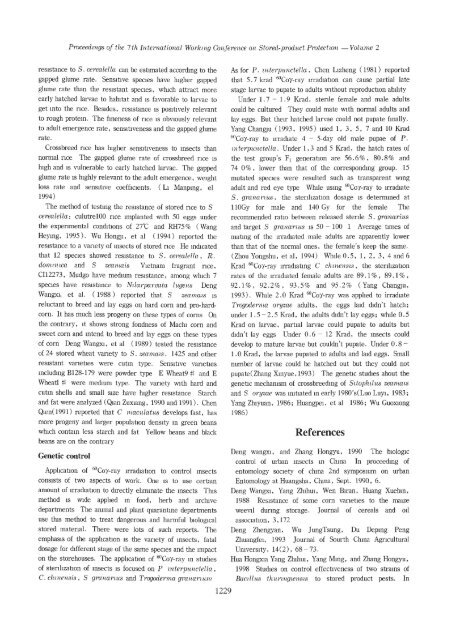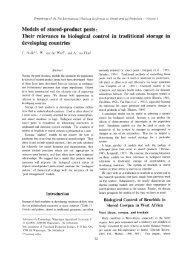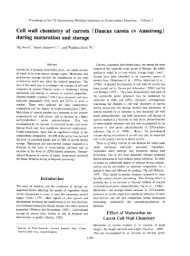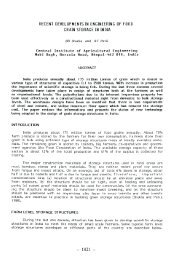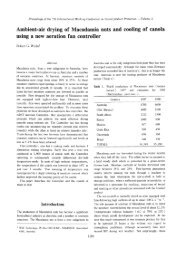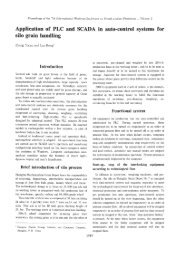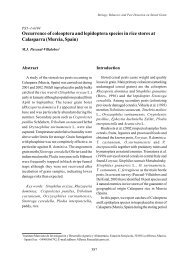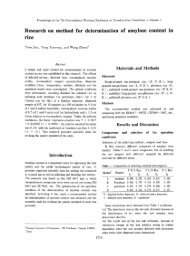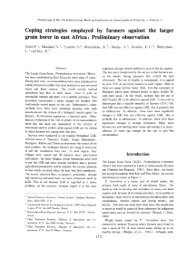Evolution of biological control of stored-product pests - SPIRU Index ...
Evolution of biological control of stored-product pests - SPIRU Index ...
Evolution of biological control of stored-product pests - SPIRU Index ...
You also want an ePaper? Increase the reach of your titles
YUMPU automatically turns print PDFs into web optimized ePapers that Google loves.
Proceedmqe <strong>of</strong> the 7th International Workmg Conference on Stored-proiuct Proiecium - Volume 2<br />
resistance to S. cerealella can be estimated according to the<br />
gapped glume rate. Sensitive species have higher gapped<br />
glume rate than the resistant species, which attract more<br />
early hatched larvae to habitat and IS favorable to larvae to<br />
get into the nee. Besides, resistance IS positively relevant<br />
to rough protem. The fineness <strong>of</strong> nee IS obviously relevant<br />
to adult emergence rate, sensitiveness and the gapped glume<br />
rate.<br />
Crossbreed rice has higher sensitiveness to insects than<br />
normal nee The gapped glume rate <strong>of</strong> crossbreed nee IS<br />
high and IS vulnerable to early hatched larvae. The gapped<br />
glume rate IShighly relevant to the adult emergence, weight<br />
loss rate<br />
1994)<br />
and sensitive coefficients. (L1 Manpmg, el<br />
The method <strong>of</strong> testing the resistance <strong>of</strong> <strong>stored</strong> nee to S<br />
cerealeila.. culutre100 nee Implanted WIth 50 eggs under<br />
the expenmental conditions <strong>of</strong> 27°C and RH75% (Wang<br />
Heying, 1995). Wu Hongji, et al (1994) reported the<br />
resistance to a vanety <strong>of</strong> insects <strong>of</strong> <strong>stored</strong> nee He indicated<br />
that 12 species showed resistance to S. cerealella, R.<br />
dommica and S zeamais VIetnam fragrant nce ,<br />
C112273, Mudgo have medium resistance, among which 7<br />
species have resistance to Nuarpariaui luqens Deng<br />
Wangxi, et al. (1988) reported that S zeanuus IS<br />
reluctant to breed and lay eggs on hard corn and pro-hardcorn.<br />
It has much less progeny on these types <strong>of</strong> corns On<br />
the contrary, It shows strong fondness <strong>of</strong> MachI corn and<br />
sweet corn and mtend to breed and lay eggs on these types<br />
<strong>of</strong> corn Deng WangxI, et al ( 1989) tested the reSIstance<br />
<strong>of</strong> 24 <strong>stored</strong> wheat vanety to S. zeamms. 1425 and other<br />
reSIstant vanetIes were cutm type. SenSItive vane ties<br />
mcludmg B128-179 were powder type E Wheat9:# and E<br />
Wheatl:# were medIum type. The vanety WIth hard and<br />
cutm shells and small SIze have hIgher reSIstance Starch<br />
and fat were analyzed (QIan Zuxiang, 1990 and 1991). Chen<br />
QIen(l991) reported that C mac'ldatus develops fast, has<br />
more progeny and larger population densIty m green beans<br />
whIch contam less starch and fat<br />
beans are on the contrary<br />
Yellow beans and black<br />
Genetic <strong>control</strong><br />
Application <strong>of</strong> 60Coy-ray IrradIation to <strong>control</strong> msects<br />
conSIsts <strong>of</strong> two aspects <strong>of</strong> work. One IS to use certam<br />
amount <strong>of</strong> Irradiation to dIrectly elImmate the msects ThIS<br />
method IS Wide applied m food, herb and archIve<br />
departments The ammal and plant quarantme departments<br />
use thIS method to treat dangerous and harmful blOlogical<br />
<strong>stored</strong> matenal. There were lots <strong>of</strong> such reports. The<br />
emphasIs <strong>of</strong> the application IS the vanety <strong>of</strong> msects, fatal<br />
dosage for dIfferent stage <strong>of</strong> the same speCiesand the Impact<br />
on the storehouses. The application <strong>of</strong> 60Coy-raym studIes<br />
<strong>of</strong> stenlIzatIon <strong>of</strong> msects IS focused on P mterpunctella,<br />
C. chmensis, S grananus and Trogoderma gTanarzum<br />
1229<br />
As for P. uuerpunctella., Chen Lizheng (1981) reported<br />
that 5.7 krad 60Coy-ray irradiation can cause partial late<br />
stage larvae to pupate to adults WIthoutre<strong>product</strong>ion ability<br />
Under 1.7 - 1.9 Krad , stenle female and male adults<br />
could be cultured They could mate WIth normal adults and<br />
lay eggs. But therr hatched larvae could not pupate fmally.<br />
Yang Changju (1993, 1995) used 1, 3, 5, 7 and 10 Krad<br />
60Coy-ray to irradiate 4 - 5-day old male pupae <strong>of</strong> P.<br />
rnterpunctella . Under 1,3 and 5 Krad, the hatch rates <strong>of</strong><br />
the test group's FI generation are 56.6%, 80.8% and<br />
74 0%, lower than that <strong>of</strong> the corresponding group. 15<br />
mutated species were resulted such as transparent Wing<br />
adult and red eye type While using 6°Coy_rayto irradiate<br />
S. grana nus , the stenhzation dosage IS determmed at<br />
1l0Gy for male and 140 Gy for the female The<br />
recommended ratio between released stenle S. gTanarius<br />
and target S qranarius IS 50 - 100 1 Average times <strong>of</strong><br />
matmg <strong>of</strong> the irradiated male adults are apparently lower<br />
than that <strong>of</strong> the normal ones, the female's keep the same.<br />
(Zhou Yongshu, et al, 1994) While 0.5, 1, 2, 3, 4 and 6<br />
Krad 60Coy-ray irradiatmg C chinensis , the stenhzation<br />
rates <strong>of</strong> the Irradiated female adults are 89.1 %, 89.1 % ,<br />
92.1%,92.2%,93.5% and 95.2% (Yang Changju,<br />
1993). While 2.0 Krad 6OCoy-raywas applied to irradiate<br />
Trogoderma oryzae adults, the eggs laid didn't hatch;<br />
under 1. 5 - 2.5 Krad, the adults dIdn't lay eggs; whIle 0.5<br />
Krad on larvae, partial larvae could pupate to adults but<br />
dIdn't lay eggs Under 0.6 - 12 Krad, the msects could<br />
develop to mature larvae but couldn't pupate. Under 0.8 -<br />
1.0 Krad, the larvae pupated to adults and laid eggs. Small<br />
number <strong>of</strong> larvae could be hatched out but they could not<br />
pupate(Zhang Xmyue, 1993) The genetic studIes about the<br />
genetic mechamsm <strong>of</strong> crossbreedmg <strong>of</strong> Sl,tophl,lus zeamaLS<br />
and S oryzae was mitIated m early 1980's(Luo LUYI,1983;<br />
Yang ZhIyuan, 1986; HuangpeI, et al 1986; Wu GuoxlOng<br />
1986)<br />
References<br />
Deng wangxI, and Zhang Hongyu, 1990 The bIOlogIC<br />
<strong>control</strong> <strong>of</strong> urban msects m Chma In proceedmg <strong>of</strong><br />
entomology SOCIety<strong>of</strong> chma 2nd symposmm on urban<br />
Entomology at Huangsha, Chma, Sept. 1990, 6.<br />
Deng WangxI, Yang ZhihUl, Wen Biran, Huang Xuebm,<br />
1988 ReSIstance <strong>of</strong> some corn vanetIes to the maize<br />
weeVIl dunng storage. Journal <strong>of</strong> cereals and 011<br />
assocIation, 3, 172<br />
Deng Zhengyan, Wu JungTsung, Du Depmg Peng<br />
ZhuangfeI, 1993 Journal <strong>of</strong> Sourth Chma Agncultural<br />
UmversIty, 14(2), 68 -73.<br />
Hua HongxIa Yang ZhihUl, Yang Mmg, and Zhang Hongyu,<br />
1998 StudIes on <strong>control</strong> effectiveness <strong>of</strong> two strams <strong>of</strong><br />
BaCillus thurzngLenS1S to <strong>stored</strong> <strong>product</strong> <strong>pests</strong>. In


